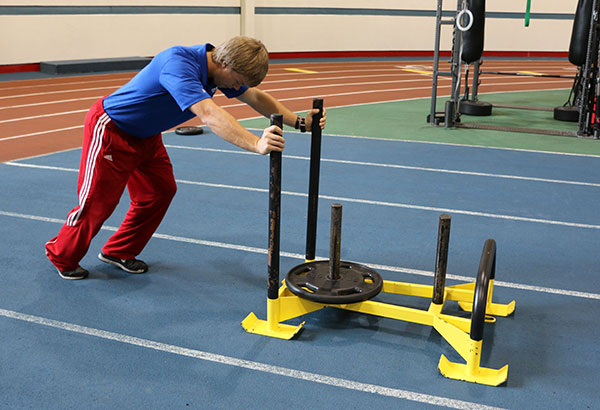 February is Heart Health Month! Heart disease is the leading cause of death for both men and women. One of the most important things you can do to increase your heart health and decrease your risk for heart disease is to take a look at your diet. Are you eating the foods that are good for your heart and sparingly consuming the foods that aren’t?
February is Heart Health Month! Heart disease is the leading cause of death for both men and women. One of the most important things you can do to increase your heart health and decrease your risk for heart disease is to take a look at your diet. Are you eating the foods that are good for your heart and sparingly consuming the foods that aren’t?
Here are five questions to ask yourself about your diet.
- How much sodium are you eating? Hypertension or high blood pressure is a major risk factor for heart disease. One of the best ways to decrease your blood pressure or to prevent high blood pressure is to watch the amount of sodium in your diet. It's in everything these days. However, it is not in fresh foods such as fruits and vegetables, and lean meats. The worst foods are those that are typically processed and packaged, and food when you are dining out. When grocery shopping, try to stay on the outside aisles of the store and avoid purchasing a lot of items down the center aisles. This tends to be the area where the higher-sodium foods are located. Try to decrease how many times you eat out per week. When you do dine out, be sure to drink plenty of water to help flush out the excess that is bound to be in your food.
- Are you choosing low-fat animal protein sources? Saturated fat is the fat that is found in animal products and is directly linked to elevated cholesterol and increasing the risk for heart disease. Most individuals get their protein from meat, resulting in high saturated fat consumption. The best way to watch the amount you are taking in is to choose lower-fat protein sources such as those from fish that is grilled or baked, white-meat chicken and turkey without skin, center cuts of pork, and lean cuts of red meat such as filet or sirloin.
- Are you eating fruits and veggies with every meal? Prepare them any way you like, and shoot for a few portions at each meal. Toss fruit into your oatmeal or yogurt and add veggies to your eggs at breakfast. At lunchtime it’s easy to grab a veggie as your side to your sandwich. Fruit is an easy and portable snack any time of day, and half of your plate should be covered with vegetables at dinner! These nutrient powerhouses are loaded with fiber. Fiber helps to decrease the cholesterol in your body, which can be very heart protective.
- Where are the high-fiber carbohydrates? Carbohydrates have gotten a bad rap in recent years, mainly due to the increased intake of highly processed and unnatural carbohydrate sources. Carbs are important and help supply the body with energy it needs to run various systems of the body. Portion control is key here (1 to 2 cupped-hand-sized servings) and so is choosing the kind of carbohydrate. Choose whole grains, beans, lentils, and fruits that are unprocessed the majority of the time.
- Are you eating the right kinds of fat? Fat in your diet is important; however, the type of fat you are choosing is key. Remember that animal fat is the not-good-for-your-heart fat, along with foods that are packaged to have a long shelf life and those that are deep fried. The good fats are those from vegetable sources such as nuts, olive oil, avocado, and fatty fish like salmon. Choose these types of fat the majority of the time, being aware of portion sizes though, since they carry a lot of calories with them also.
If you have a family history of heart disease, you should definitely be asking yourself these five questions and working toward healthy eating habits. Take time this month to reflect on your heart health, decrease your sodium intake, and increase your fiber and good-for-you fats!
This blog was written by Angie Mitchell, RD, Wellness Coordinator. To find out more about the NIFS bloggers, click here.


 It happens every year. As the new year rolls around, we set our new fitness goals and get excited to get started on them and “make this year the year!” But with winter still here through the end of March, many of us end up with the goal to get fit, but with no motivating factors to flip the switch in our brains to get out of hibernation mode. It gets easier in the spring and summer, when we can start to change up the environment we work out in, the workload at the office might be lighter, and there is more daylight before the sun goes down. But what do we do until then?
It happens every year. As the new year rolls around, we set our new fitness goals and get excited to get started on them and “make this year the year!” But with winter still here through the end of March, many of us end up with the goal to get fit, but with no motivating factors to flip the switch in our brains to get out of hibernation mode. It gets easier in the spring and summer, when we can start to change up the environment we work out in, the workload at the office might be lighter, and there is more daylight before the sun goes down. But what do we do until then? When it comes to working out, the first weeks are usually great. You are excited to get to the gym, and you love the feeling of exercising. Once the “honeymoon” stage of your new workout routine is over, it gets more challenging to get to the gym:
When it comes to working out, the first weeks are usually great. You are excited to get to the gym, and you love the feeling of exercising. Once the “honeymoon” stage of your new workout routine is over, it gets more challenging to get to the gym:  Every four years, the
Every four years, the  The concept of cross-country skiing for sport comes from areas in which getting around is easier and more common on skis than trudging through the snow. Out of necessity and the evolution of transportation, people in the Nordic region of Europe are now famously known for producing some of the highest VO2 Max numbers in the world. Your
The concept of cross-country skiing for sport comes from areas in which getting around is easier and more common on skis than trudging through the snow. Out of necessity and the evolution of transportation, people in the Nordic region of Europe are now famously known for producing some of the highest VO2 Max numbers in the world. Your  One of the most fascinating events at the winter Olympics is the bobsled. A team of individuals, working as one, propels a bobsled down a narrow, icy chute. To get the sled going, the team relies heavily on otherworldly leg strength. The rest of the event takes skill and some luck, as this is a race to the finish line. The winning team usually has a complete balance of strength, skill, balance, and weight.
One of the most fascinating events at the winter Olympics is the bobsled. A team of individuals, working as one, propels a bobsled down a narrow, icy chute. To get the sled going, the team relies heavily on otherworldly leg strength. The rest of the event takes skill and some luck, as this is a race to the finish line. The winning team usually has a complete balance of strength, skill, balance, and weight. Every couple of years, the world’s best athletes get to compete in either the winter or summer Olympics, and I have been wondering about what they eat! I know as a dietitian I am obsessed with food, but surely other people wonder about sports nutrition on this kind of scale, too. These elite athletes have a routine when it comes to their nutrition, especially before competition. Then they are put into a situation where they have a giant smorgasbord of choices in the Olympic Village. How hard it must be to try to stick to their plan…at least until their event is over.
Every couple of years, the world’s best athletes get to compete in either the winter or summer Olympics, and I have been wondering about what they eat! I know as a dietitian I am obsessed with food, but surely other people wonder about sports nutrition on this kind of scale, too. These elite athletes have a routine when it comes to their nutrition, especially before competition. Then they are put into a situation where they have a giant smorgasbord of choices in the Olympic Village. How hard it must be to try to stick to their plan…at least until their event is over. Like most people, I’m busy: full-time job, kids, a house… and in my “spare time,” I’m a high school tennis coach and play a lot of tennis. A few years back I started having issues with exhaustion (go figure). Right around 4pm I would just be overcome with complete, hit-the-couch, exhaustion. The only way to make it through the rest of my busy day seemed to be one more caffeinated drink.
Like most people, I’m busy: full-time job, kids, a house… and in my “spare time,” I’m a high school tennis coach and play a lot of tennis. A few years back I started having issues with exhaustion (go figure). Right around 4pm I would just be overcome with complete, hit-the-couch, exhaustion. The only way to make it through the rest of my busy day seemed to be one more caffeinated drink. I love what I do…seeing people succeed with their weight-loss goals is one of the most rewarding feelings as a dietitian. However, it can also be very challenging when I see clients revert back to old habits and struggle to keep the weight off that they worked so hard to remove. While this is a common struggle for many, there are small steps that you can take to try to prevent this from happening.
I love what I do…seeing people succeed with their weight-loss goals is one of the most rewarding feelings as a dietitian. However, it can also be very challenging when I see clients revert back to old habits and struggle to keep the weight off that they worked so hard to remove. While this is a common struggle for many, there are small steps that you can take to try to prevent this from happening.